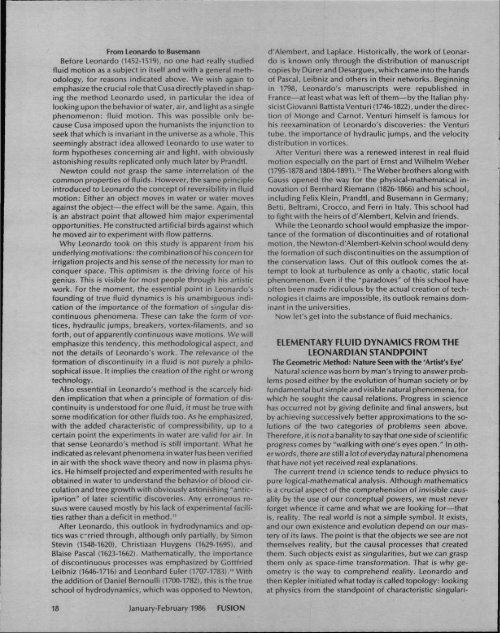And Hypersonic Flight
And Hypersonic Flight
And Hypersonic Flight
You also want an ePaper? Increase the reach of your titles
YUMPU automatically turns print PDFs into web optimized ePapers that Google loves.
From Leonardo to BusemannBefore Leonardo (1452-1519), no one had really studiedfluid motion as a subject in itself and with a general methodology,for reasons indicated above. We wish again toemphasize the crucial role that Cusa directly played in shapingthe method Leonardo used, in particular the idea oflooking upon the behavior of water, air, and light as a singlephenomenon: fluid motion. This was possible only becauseCusa imposed upon the humanists the injunction toseek that which is invariant in the universe as a whole. Thisseemingly abstract idea allowed Leonardo to use water toform hypotheses concerning air and light, with obviouslyastonishing results replicated only much later by Prandtl.Newton could not grasp the same interrelation of thecommon properties of fluids. However, the same principleintroduced to Leonardo the concept of reversibility in fluidmotion: Either an object moves in water or water movesagainst the object—the effect will be the same. Again, thisis an abstract point that allowed him major experimentalopportunities. He constructed artificial birds against whichhe moved air to experiment with flow patterns.Why Leonardo took on this study is apparent from hisunderlying motivations: the combination of his concern forirrigation projects and his sense of the necessity for man toconquer space. This optimism is the driving force of hisgenius. This is visible for most people through his artisticwork. For the moment, the essential point in Leonardo'sfounding of true fluid dynamics is his unambiguous indicationof the importance of the formation of singular discontinuousphenomena. These can take the form of vortices,hydraulic jumps, breakers, vortex-filaments, and soforth, out of apparently continuous wave motions. We willemphasize this tendency, this methodological aspect, andnot the details of Leonardo's work. The relevance of theformation of discontinuity in a fluid is not purely a philosophicalissue. It implies the creation of the right or wrongtechnology.Also essential in Leonardo's method is the scarcely hiddenimplication that when a principle of formation of discontinuityis understood for one fluid, it must be true withsome modification for other fluids too. As he emphasized,with the added characteristic of compressibility, up to acertain point the experiments in water are valid for air. Inthat sense Leonardo's method is still important. What heindicated as relevant phenomena in water has been verifiedin air with the shock wave theory and now in plasma physics.He himself projected and experimented with results heobtained in water to understand the behavior of blood circulationand tree growth with obviously astonishing "anticipation"of later scientific discoveries. Any erroneous resultswere caused mostly by his lack of experimental facilitiesrather than a deficit in method."After Leonardo, this outlook in hydrodynamics and opticswas crried through, although only partially, by SimonStevin (1548-1620), Christiaan Huygens (1629-1695), andBlaise Pascal (1623-1662). Mathematically, the importanceof discontinuous processes was emphasized by GottfriedLeibniz (1646-1716) and Leonhard Euler (1707-1783). M Withthe addition of Daniel Bernoulli (1700-1782), this is the trueschool of hydrodynamics, which was opposed to Newton,d'Alembert, and Laplace. Historically, the work of Leonardois known only through the distribution of manuscriptcopies by Diirer and Desargues, which came into the handsof Pascal, Leibniz and others in their networks. Beginningin 1798, Leonardo's manuscripts were republished inFrance—at least what was left of them—by the Italian physicistGiovanniBattistaVenturi (1746-1822), under the directionof Monge and Carnot. Venturi himself is famous forhis reexamination of Leonardo's discoveries: the Venturitube, the importance of hydraulic jumps, and the velocitydistribution in vortices.After Venturi there was a renewed interest in real fluidmotion especially on the part of Ernst and Wilhelm Weber(1795-1878 and 1804-1891).' 5 The Weber brothers along withGauss opened the way for the physical-mathematical innovationof Bernhard Riemann (1826-1866) and his school,including Felix Klein, Prandtl, and Busemann in Germany;Betti, Beltrami, Crocco, and Ferri in Italy. This school hadto fight with the heirs of d'Alembert, Kelvin and friends.While the Leonardo school would emphasize the importanceof the formation of discontinuities and of rotationalmotion, the Newton-d'Alembert-Kelvin school would denythe formation of such discontinuities on the assumption ofthe conservation laws. Out of this outlook comes the attemptto look at turbulence as only a chaotic, static localphenomenon. Even if the "paradoxes" of this school haveoften been made ridiculous by the actual creation of technologiesit claims are impossible, its outlook remains dominantin the universities.Now let's get into the substance of fluid mechanics.ELEMENTARY FLUID DYNAMICS FROM THELEONARDIAN STANDPOINTThe Geometric Method: Nature Seen with the 'Artist's Eye'Natural science was born by man's trying to answer problemsposed either by the evolution of human society or byfundamental but simple and visible natural phenomena, forwhich he sought the causal relations. Progress in sciencehas occurred not by giving definite and final answers, butby achieving successively better approximations to the solutionsof the two categories of problems seen above.Therefore, it is not a banality to say that one side of scientificprogress comes by "walking with one's eyes open." In otherwords, there are still a lot of everyday natural phenomenathat have not yet received real explanations.The current trend in science tends to reduce physics topure logical-mathematical analysis. Although mathematicsis a crucial aspect of the comprehension of invisible causalityby the use of our conceptual powers, we must neverforget whence it came and what we are looking for—thatis, reality. The real world is not a simple symbol. It exists,and our own existence and evolution depend on our masteryof its laws. The point is that the objects we see are notthemselves reality, but the causal processes that createdthem. Such objects exist as singularities, but we can graspthem only as space-time transformation. That is why geometryis the way to comprehend reality. Leonardo andthen Kepler initiated what today is called topology: lookingat physics from the standpoint of characteristic singulari-18 January-February 1986 FUSION
















